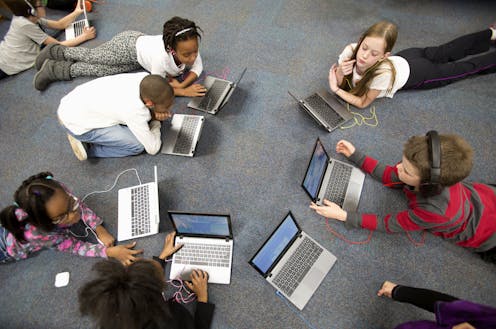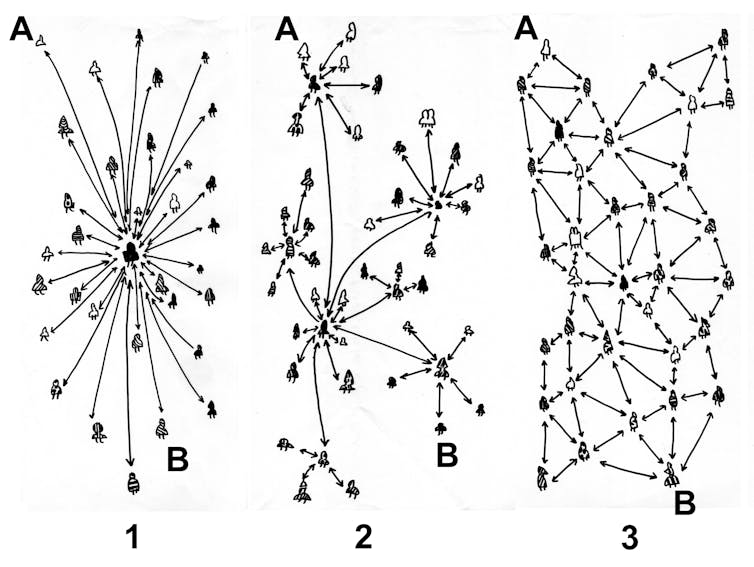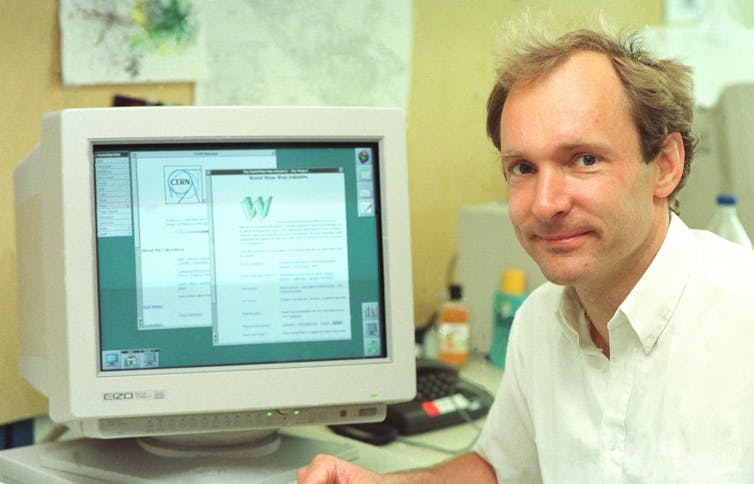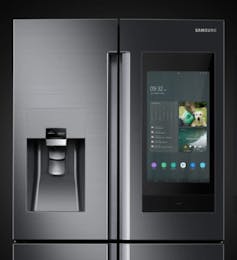What exactly is the internet? A computer scientist explains what it is and how it came to be
Almost everybody uses the internet just about every day. But do you really know what the internet is?


Curious Kids is a series for children of all ages. If you have a question you’d like an expert to answer, send it to curiouskidsus@theconversation.com.
What exactly is the internet? Nora, age 8, Akron, Ohio
The internet is a global collection of computers that know how to send messages to one another. Practically everything connected to the internet is indeed a computer – or has one “baked inside” of it.
In the early 1960s, computers were used only for special purposes, like scientific research. There weren’t a lot of them because they were large and expensive. One computer and its attached accessories could easily fill a room. To exchange data, people would plan time to work together, and one computer would connect to another with a telephone call.
The U.S. government wanted a network that would allow computers to communicate automatically and even if some telephone lines were cut off. Suppose you wanted to send a message from Computer A to Computer B in each of three different types of networks. The first is a network with one central computer connected to all the others as spokes. The second is a network of several of these hub-and-spoke networks with their hubs connected. The third is a network where every computer is connected to several others, forming a kind of mesh. Which do you think would be most reliable if some computers and links were damaged?

The first network is vulnerable, because if the central computer is lost, then none of the computers can communicate. The second network is vulnerable because if any of the hub computers are lost, the path between A and B is cut. But in the third network, many individual computers and links could be lost and there would still be a path to connect A and B. So the third network would be the most reliable.
Hot potatoes
An American engineer named Paul Baran worked on this problem at a company called the Rand Corp. In 1962, he published a new idea for computer networks, which he called “hot potato networking.”
In Baran’s idea, a message would be broken up into lots of little pieces – the potatoes. When Computer A wanted to sent its message to Computer B, it would individually send the little potatoes to a neighbor computer. That computer would pass it along in the right direction as soon as it could. To make sure messages were delivered quickly, the message pieces were treated as if they were hot, so you didn’t want them in your hands for too long.
The messages included a sequence number so when they arrived at Computer B, the final destination computer, that machine would know how to put them in the proper order to receive the full message.
Baran’s idea got implemented as the ARPANET. This network was the immediate predecessor to today’s internet.
Instead of hot potatoes, the system got a more formal name, which we still use: “packet switched networking.” The potato got renamed as a packet – a small piece of the full message.
Vinton Cerf, an American computer scientist, is known as one of the fathers of the internet. He contributed many essential ideas, including that the receiving computer could ask the sending computer for a packet that went missing – which they sometimes do. This has the name Transmission Control Protocol, or TCP.
A web of pages
Another important contributor was Tim Berners-Lee, a British computer scientist. Berners-Lee was working at CERN, the European Organization for Nuclear Research. He wanted to create a system for his colleagues to better share their research results with one another.

Around 1990, Berners-Lee came up with the idea that a computer could host a collection of “pages,” each of which had text, images and links to other pages. He created an easy way for links to specify any computer – the concept of the URL, or Uniform Resource Locator.
Berners-Lee named the system the World Wide Web. He wrote the code for the first web browser, to view web pages, and web server, to deliver them. If you see a URL that includes “www” – that’s from the original name.
Berners-Lee may have been planning to use the web particularly to share text, images and files. But the earlier work on the internet made the web suitable for video and sound, too. YouTube, Instagram and TikTok are built using the same rules, or protocols, developed by Cerf and Berners-Lee.
Internet of Things
In the past 20 years, computers have become even more powerful and inexpensive. Now, a computer chip that can connect directly to the internet sells for US$5 – a lot less than today’s laptops and cellphones (about $300) or yesterday’s room-size computers ($1 million or more!).

This lower cost has led to millions upon millions of devices connected to the internet. These devices include sensors. A smart thermostat monitors your house using a temperature sensor. A security camera keeps an eye on your front porch using an array of tiny light sensors.
These devices also include actuators – mechanisms that control activity in the physical world. For example, a smart thermostat can turn on and off the heating and cooling systems in your house.
Together, all these smart devices are called the Internet of Things, or IoT. The internet includes not only computers and phones, but all these IoT devices. You may have a smart refrigerator that has a camera inside of it. When it notices you’re out of milk, it will send a message to your cellphone, reminding you to buy more.
Just about everything is connected to the internet now.
Hello, curious kids! Do you have a question you’d like an expert to answer? Ask an adult to send your question to CuriousKidsUS@theconversation.com. Please tell us your name, age and the city where you live.
Fred Martin receives funding from the National Science Foundation and Google.
Read These Next
What’s at stake in Trump’s executive order aiming to curb state-level AI regulation
In the absence of comprehensive federal AI regulation, states have stepped in. The Trump administration,…
Sleep problems and depression can be a vicious cycle, especially during pregnancy − here’s why it’s
Inadequate sleep can have negative downstream effects on everyday cognitive functioning and mental health,…
Can scientists detect life without knowing what it looks like? Research using machine learning offer
A new machine learning model explores the boundary between biological and nonbiological chemistry.





